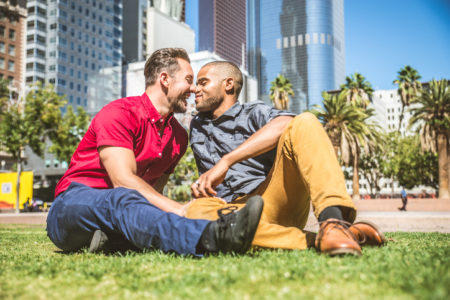Lighthouse therapist Deanna Richards offers advice for queer people in multiethnic and multiracial relationships.
Public discussions about intersectionality are becoming increasingly — and encouragingly — mainstream. And while talking about intersectionality and allowing it to actually inform our everyday actions are two very different things, the importance of educating the average person on the ways in which systems of social oppression interact with — and often compound — one another should not be understated.
But when it comes to romantic relationships, it can be difficult for even the wokest among us to put this intersectional sensitivity into practice. Navigating the pitfalls of a modern relationship is challenging enough even when both partners enjoy every imaginable kind of privilege, but doing so is even more complicated when mechanisms of structural inequality enter into the equation.
With this in mind, we sat down with Lighthouse therapist Deanna Richards to discuss the unique issues encountered in multiracial and multiethnic queer relationships, the ways in which people with differing racial or ethnic identities can and should support their partners, and the deep connections that can develop when partners make an effort to recognize the external forces at play — fairly or not — in their own lives.
White Partners: Recognize Your Privilege
The ways in which each partner relates to race and ethnicity can have a significant effect on the dynamics of a multiethnic queer relationship. A relationship in which one partner is white and the other is a person of color tends to involve a different set of considerations than a relationship in which both partners identify as people of color with the same or different ethnic backgrounds.
“Open and honest communication is absolutely essential for relationships in which one partner is white and one is not,” says Richards. “The couple needs to be able to constructively engage in conversations about white privilege,” she explains, “both how it manifests in the relationship itself and how it plays out in social spaces.”
Understanding Multiple Minority Stress
White partners may think that, as members of the queer community, they understand their partner’s experience as a queer person of color. And while they may certainly be more empathetic to it, minority stress (and double minority stress) impacts different people in different ways, and the stressors associated with being queer may not be the same as those associated with living as a visible person of color.
“During the holidays especially, there’s a lot of engagement with families who are still grappling with stereotypes and prejudice that have to do with both being gay and being a person of color,” says Richards. “That’s a good opportunity to start conversations about privilege and overlapping minority stress. If grandma has a problem with gay people, it may be easy for the white partner to understand and support their partner. There’s a feeling of, ‘we’re in this together,’” Richards explains.
“But when grandma has a problem with black people, too, that piece can get lost, either because the white partner isn’t comfortable talking about it, or because they’re just not thinking about it,” Richards continues. “The white partner should ask themselves, ‘What kinds of minority stress is my partner experiencing because they are queer and of color? What are they experiencing that I am not, and how can I support them through it?’ Creating ways to address this in a relationship can be really meaningful and empowering.”
Read More: A Therapist’s Guide to Better Care for Queer Patients of Color
Navigating Social Spaces Together
White partners don’t always acknowledge the privilege that they enjoy in queer social spaces, often because they don’t recognize — and have the luxury of not having to recognize, which really is white privilege in a nutshell — when a space is predominantly white or when people of color’s voices are not given an equitable platform.
“Entering predominantly white spaces can be difficult for a person who is accustomed to spending time in communities of color,” says Richards. “White partners need to actively acknowledge this imbalance, be aware, and be able to communicate with their partner. This requires partners to establish a language in which they can comfortably discuss these dynamics.”
This type of honest, deliberate check-in process can — and often should — occur not only during an outing, but both before and afterwards as well. If a multiethnic couple anticipates entering a space that might not be racially or ethnically diverse, it’s important for the couple to discuss whether the partner of color has any concerns or trepidations about the outing and, even if they don’t, what kind of support they would like or expect from their white partner during the event.
If in the course of an outing the partner of color experiences, for instance, a microaggression, it’s critical for their white partner to both validate the experience (“yes, that did just happen”) and make an effort to support as appropriate. As Richards points out, “For a person of color, experiencing a microaggression can be really maddening, really triggering, because oftentimes our reaction is, ‘Did that just happen?’ If a white partner questions such an offense or fails to validate their partner’s experience, this can lead to the victim experiencing a sense of isolation that is healthy unhealthy for them as an individual and for the relationship.”
The bottom line: white partners who are part of a multiethnic relationship have a responsibility to be aware of the social traumas inflicted upon people of color, the extra level of stress queer people of color must contend with that queer white people do not, and the different ways that a person’s racial, ethnic, or cultural identity can inflect their queer identity when it comes to things like being out in various spaces.
Read More: A Therapist’s Guide to Navigating Your Partner’s Bisexuality
Making Room for Multiple Cultural and Ethnic Backgrounds to Coexist
According to Richards, much of this advice carries over to couples comprised of two people of color from different racial or ethnic backgrounds — especially the importance of good communication.
“Even in queer relationships between two black people, each partner will often have a significantly different lived experience,” she says. While there will likely be a shared understanding of the unique stressors that accompany life as a queer person of color, each partner’s individualized experience — whether related to the relative darkness or lightness of their skin, the specific cultural environment in which they were raised, or something else — is still equally important.
“Both partners need to educate themselves,” Richards suggests. “Different cultural backgrounds, different ethnic backgrounds, different ways of interacting with different people in different spaces — finding room to learn about each other in all of these ways can be very valuable for both partners.”
This reflexive, collaborative education is especially important when it comes to life events like getting married or having children. “Partners need to be aware of dominant cultural privilege, that is, when one partner’s cultural practices are overshadowing the other’s,” Richards explains. If, for instance, one partner comes from a family that has resided in the United States for generations and the other is a first-generation immigrant, the couple should be careful to not let the first partner’s more dominant “American” way of doing things dictate how their wedding is planned.
Read More: A Therapist’s Guide to Open Relationships
Starting the Conversation
Discussing these kinds of issues in a deeply personal way can be difficult, so Richards recommends using “conversation starters” like a topical movie or book as an entryway into talking about how each partner feels about various issues. “This way it’s a little less personal because you’re not talking about your own experiences, but using something as a way to invite conversation,” says Richards.
If and when a couple is able to have these conversations, they oftentimes will develop a deeper, more authentic level of intimacy than otherwise possible. If, however, a couple has a difficult time engaging in these conversations, it can be a great time to bring a therapist like Richards into the picture.
The right professional can help equip a couple with the tools and resources necessary to build toward important conversations and, ultimately, a more well-rounded understanding of one another.
To book an appointment with Deanna Richards, click here. To visit her website, click here.


